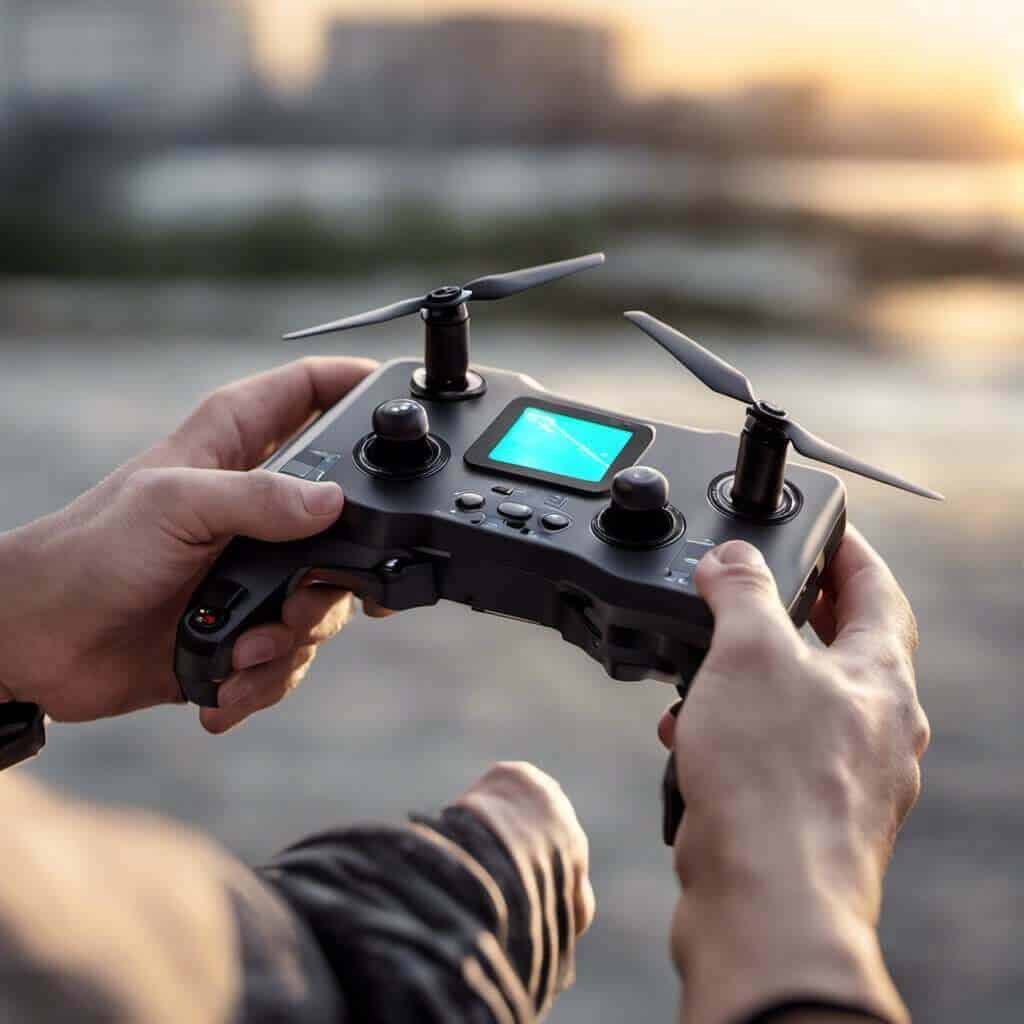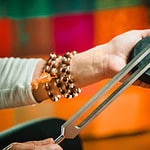You might find the remote controller intimidating if you are new to drone flying. With all the buttons, switches, and joysticks, it can be overwhelming to know where to start. However, understanding the remote controller is essential to flying your drone safely and effectively.
The remote controller is the device used to send commands to your drone and control its movements. It communicates with the drone through a wireless connection, allowing you to control its flight path, altitude, and speed.
Role of Drone Pilot in Remote Controller Operations
As a drone pilot, your role in remote controller operations is crucial. You are responsible for ensuring the safe and efficient operation of the drone, as well as the protection of people and property on the ground.
To operate a drone, you must use a drone remote controller, which allows you to control the drone’s flight and camera functions. The user interface on the remote controller displays essential information such as altitude, speed, battery level, and GPS location. You must familiarize yourself with the user interface and understand how to interpret this information.
When operating a drone, following all regulations and guidelines set forth by the Federal Aviation Administration (FAA) and any local authorities is essential, including obtaining the necessary permits and certifications and complying with airspace restrictions and safety guidelines.
As the drone pilot, you must constantly communicate with other operators or personnel involved, providing clear instructions and updates on the drone’s status and location.
It is crucial to have a thorough understanding of the drone’s capabilities and limitations. You can plan and execute safe and effective drone operations by understanding the drone’s flight characteristics, range, and payload capacity. Our guide
Understanding the Basics of Drone Remote Controller
When you start flying a drone, the remote controller becomes your lifeline as it controls your drone’s movements, altitude, and other features.
The drone remote controller is a handheld device that communicating with the drone via radio waves. It sends commands to the drone, and the drone responds accordingly. The remote controller typically has two joysticks, which control the drone’s movements. The left joystick controls the altitude and rotation of the drone, while the right joystick controls its forward, backward, left, and right movements.
The remote controller also has other buttons and switches that control various features of the drone. Some of these buttons include the power button, the takeoff and landing button, the return to home button, and the camera button. These buttons allow you to perform different functions with your drone.
One essential feature of a drone’s remote controller is the signal range. The maximum distance the remote controller can communicate with the drone is the signal range. It is crucial to understand the signal range of your drone and stay within it to avoid losing control of the drone.
Another critical aspect of the remote controller is the battery life. The remote controller requires battery power to function, and it is essential to ensure that the battery is fully charged before flying the drone. It would help if you also carried extra batteries to ensure you will not run out of power in the middle of a flight.
Components Of A Drone Remote Controller
Sticks and Buttons
The sticks and buttons on a drone remote controller are the primary means of controlling the drone. The roll and pitch of the drone are adjusted with the right stick controls, while the left stick controls the throttle and yaw. The controller also has several buttons that you can use to initiate different functions, such as takeoff, landing, and return to home.
LED Indicators
LED indicators on a drone remote controller provide important information about the drone’s status and battery life. For example, a green LED indicates the drone is ready to fly, while a red one means the battery is low.
Antennas and Transmitters
The antennas and transmitters on a drone remote controller are responsible for transmitting and receiving signals to and from the drone. The controller typically has two antennas, one for transmitting and one for receiving, which are used to communicate with the drone.
Circuit Board and Firmware
The circuit board and firmware on a drone remote controller are responsible for processing the signals sent from the sticks and buttons and transmitting them to the drone. The firmware is the software that runs on the controller and is responsible for controlling the various functions of the controller.
Understanding the Drone’s Flight Controls
Understanding the flight controls is essential when flying a drone, including Lift and Throttle Control, Pitch and Roll Control, and Yaw and Trim Control.
Lift and Throttle Control
The Lift and Throttle Control is responsible for controlling the drone’s altitude. The left stick operates this control on the remote controller. Pushing the stick up will increase the throttle and lift the drone higher while pulling it down will decrease the throttle and bring the drone lower.
Pitch and Roll Control
Pitch and Roll Control is responsible for controlling the direction of the drone. This control is operated by the right stick on the remote controller. Pushing the stick forward or backward will control the drone’s pitch, while moving the stick left or right will control the roll of the drone.
Yaw and Trim Control
Yaw and Trim Control is responsible for controlling the rotation of the drone. The left and right buttons operate this control on the remote controller. Pressing the left button will rotate the drone to the left, while pressing the right button will turn the drone to the right. The Trim Control adjusts the drone’s stability and balance during flight.
It is important to note that different drones may have different flight modes, affecting how the flight controls operate. Read the drone’s manual to learn more about its specific flight modes.
Role of Sensors and Gyroscopes in Remote Controllers
When it comes to drone remote controllers, sensors and gyroscopes play a crucial role in ensuring that the drone stays stable and responds accurately to your commands. Two main types of sensors are used in remote controllers: accelerometers and gyroscopes.
Accelerometers
Accelerometers are sensors that measure the drone’s acceleration in three directions: up and down, left and right, and forward and backward. By measuring the drone’s acceleration, the accelerometer can determine its orientation and how it moves through the air.
The information is then sent to the flight controller, which uses it to adjust the speed of the motors and keep the drone stable. For example, if the drone tilts to the left, the flight controller will increase the speed of the motors on the right side to compensate and keep the drone level.
Gyroscopes
Gyroscopes, on the other hand, measure the rate of rotation of the drone around its three axes: pitch, roll, and yaw. By measuring these rotation rates, the gyroscope can determine the drone’s orientation and how it is moving through the air.
Like accelerometers, this information is transmitted to the flight controller. For example, if the drone rotates too quickly around its yaw axis, the flight controller adjusts the motor speed to stabilize it.
Wireless Communication and Radio Signals
The remote controller communicates with the drone through wireless communication, which relies on radio signals. Different types of wireless communication and radio signals are used in drone controllers.
Radio Frequency
Radiofrequency (RF) is a standard method used for wireless communication between the drone and the remote controller. The drone and the controller use a specific frequency to communicate. The frequency used depends on the type of drone and the controller. The most common frequency used for drone controllers is 2.4 GHz. This frequency is widely used because it offers a stable connection and can penetrate obstacles such as trees and buildings.
Wi-Fi Communication
Wi-Fi is another wireless communication method used in drone controllers. Wi-Fi is popular because it is easy to set up and provides a stable connection. Connecting your drone to your smartphone or tablet via Wi-Fi allows you to use it as a screen for the drone’s camera.
OcuSync 2.0 Technology
OcuSync 2.0 is a new technology developed by DJI, dji.com, allowing the drone long range and stable communication between the drone and the remote controller. OcuSync 2.0 uses Wi-Fi and RF signals to provide a more robust and stable connection. This technology is beneficial because it allows you to fly your drone up to 8 kilometres away while maintaining a stable connection.
Popular Drone Remote Controller Models
When it comes to choosing a remote controller for your drone, there are several options available.
DJI Phantom 4
The DJI Phantom 4 is a popular drone remote controller model widely used by professionals and hobbyists. It has a range of up to 7 km and comes equipped with GPS and a camera. The controller has a built-in screen that displays live footage from the camera, making it easy to monitor your flight.

DJI Mavic 2
Another popular drone remote controller model is the DJI Mavic 2. It has a range of up to 8 km and comes equipped with GPS and a camera that enables the controller to connect to your smartphone. The Mavic 2 also has obstacle avoidance sensors, which helps you to fly in challenging environments.

Model Aircraft Remote Controllers
Apart from DJI, several other companies manufacture remote controllers for drones. Model aircraft remote controllers are popular among hobbyists who build their drones. These controllers are typically customizable and offer a range of features, such as multiple channels, programmable buttons, and more.
Advanced Features in Modern Drone Remote Controllers
Modern drone remote controllers have advanced features that enhance the drone flying experience.
Return to Home Function
The Return to Home function is an essential safety feature that automatically lets your drone return to its takeoff point. The return to home feature is activated when the drone loses its connection with the remote controller or when the battery level is low.
The Return to Home function ensures that your drone returns to its takeoff point safely, even when you lose sight of it, which is a handy feature when flying in areas with poor GPS signals or when the drone is flying too far away.
Camera Control
Modern drone remote controllers have advanced camera control features that allow you to capture high quality footage and images. These features include adjusting camera settings such as ISO, shutter speed, and white balance.
You can also control the camera angle and tilt from the remote controller. This feature enables you to capture unique and creative shots that would be impossible to achieve with a fixed camera.
BVLOS (Beyond Visual Line of Sight) Operations
BVLOS (Beyond Visual Line of Sight) operations refer to flying a drone beyond the pilot’s line of sight. This feature is only available on advanced drone models and requires a special license to operate legally.
Modern drone remote controllers come equipped with BVLOS features that allow you to safely fly your drone beyond your line of sight. These features include obstacle avoidance sensors, GPS tracking, and automatic Return to Home functions.
Role of Drone Pilot in Remote Controller Operations
As a drone pilot, your role in remote controller operations is crucial. You are responsible for ensuring the safe and efficient operation of the drone, as well as the protection of people and property on the ground.
To operate a drone, you must use a drone remote controller, which allows you to control the drone’s flight and camera functions. The user interface on the remote controller displays essential information such as altitude, speed, battery level, and GPS location. You must familiarize yourself with the user interface and understand how to interpret this information.
When operating a drone, following all regulations and guidelines set forth by the Federal Aviation Administration (FAA) and any local authorities is essential, including obtaining the necessary permits and certifications and complying with airspace restrictions and safety guidelines. Our guide Introduction to Drones: Everything You Need to Know is a valuable asset there for you to review.
As the drone pilot, you must constantly communicate with other operators or personnel involved, providing clear instructions and updates on the drone’s status and location.
It is crucial to have a thorough understanding of the drone’s capabilities and limitations. You can plan and execute safe and effective drone operations by understanding the drone’s flight characteristics, range, and payload capacity.
Maintenance and Tuning of Drone Remote Controllers
Regular maintenance is essential to keep your drone remote controller in good condition. Here are some essential tips to ensure your controller stays in top shape:
- Keep the controller clean: Use a microfiber or soft cloth to wipe the controller regularly to remove dust and dirt. Avoid using water or any other liquid on the controller as it may damage the electronics.
- Check your batteries: Ensure the battery is fully charged before each flight. If the battery is low, it can affect the range and performance of the drone.
- Inspect the motors and ESC: Check the motors and Electronic Speed Controllers (ESC) for any signs of wear and tear. Replace them if necessary to ensure smooth and efficient flight.
- Tune your controller: Tuning your controller is essential to ensure the drone responds correctly to your commands. Adjust the control settings to suit your flying style and preferences.
- Switch between modes: Most drones have different flight modes, such as beginner, intermediate, and advanced. Switching between these modes can help you get the most out of your drone and improve your flying skills.
- Ensure robustness: Ensure your controller is sturdy and can withstand accidental drops or bumps. Invest in a protective case to keep it safe during transportation.
Final Thoughts
Understanding the functions and features of a drones remote controller is crucial for any drone pilot. With the right knowledge and skills, one can easily maneuver and control their drone with precision and accuracy, making their aerial photography and videography experience more enjoyable and rewarding. Whether you are a beginner or an experienced drone pilot, mastering the use of a remote controller is a must have skill that will enhance your drone flying experience. So take the time to learn and understand your drone’s remote controller, and you will be well on your way to capturing stunning aerial footage.
Frequently Asked Questions
What are the key features to look for in a drone remote control?
Look for a controller with a comfortable grip, intuitive controls, and a clear display screen. The controller should also have a good range and a long battery life to ensure you can fly your drone for extended periods.
How can I connect my drone remote control to my smartphone?
To connect your smartphone, enable the Wi-Fi or Bluetooth feature on both devices and follow the instructions provided in the user manual.
What is the range of a typical drone remote control?
The range of a drone remote control can vary depending on the model and manufacturer. However, most remote controls range up to 1-2 kilometres. It’s important to note that the range can be affected by interference from other devices, obstacles, and weather conditions.
Can I use a universal remote control for my drone?
No, a universal remote control cannot be used for a drone. Drone remote controls are designed specifically for use with drones and have unique features and functions unavailable on universal remote controls.






